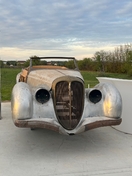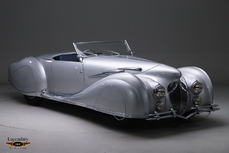Delahaye 135 135 M Cabriolet 1948
Allgemeine Beschreibung :
In the aftermath of World War II, Delahaye had survived battered but not broken. Until production of their landmark 135-series could resume, the company paid the bills by building commercial trucks and buses. Once the 135M was revised for the post-war climate, however, Delahaye was back in business as one of France’s premier sports car makers. The revised 135M was in essence the same as the pre-war model but it featured a widened track, and more powerful, refined versions of the same 3,558 c.c. six-cylinder engine, with output as high as 160 horsepower in ultimate specification. As it had before the war, Delahaye partnered with many great French coachbuilders such as Chapron, Franay, and Letourner & Marchand to skin its fabulous 135M chassis. But it was the work of Figoni et Falaschi that made the biggest impact on Delahaye’s image. The partnership was in many ways, the ideal marriage of the flamboyant high-style of Figoni, and the engineering excellence of Delahaye.
Giuseppe “Joseph” Figoni was born in Italy in 1894, and immigrated to France with his parents when he was just three years old. As a teenager, he apprenticed with a carriage-maker before serving in the French military for seven years. In 1923, he opened his own body repair shop in Boulogne and quickly won the admiration of clientele who called upon his skills for not only repairs, but also for his ability to perform modifications to suit his clients’ wishes. Inevitably, this grew into a full-fledged carrosserie by 1925. He exhibited a natural talent for proportions and detailing, continuing to build upon his reputation for high quality craftsmanship. In 1935, Figoni partnered with Ovidio Falaschi, a Tuscan businessman with a penchant for fast, stylish motorcars. Falaschi’s financial backing allowed Figoni to experiment with increasingly flamboyant designs, yet he managed to maintain his fine sense of balance and proportion. The Goutte d’Or (literally “drop of gold”) coupe on a Talbot T-150 marked his arrival as a true Avant Garde stylist, one that would attract the attention of the world’s elite figures.
One such figure was T’hami El Glaoui, who served as the Pasha of Marrakesh. El Glaoui was an influential figure in Moroccan politics, which was a French held colony at the time. His powerful stature in the caste system and his sympathetic stance with the French government afforded him many business opportunities at home and abroad; enough to amass a huge fortune that at one point topped $50M. El Glaoui enjoyed the fruits of his fortune, indulging in multiple palaces and the finest of French automobiles. In the late 1940s, T’hami El Glaoui commissioned Figoni et Falaschi to construct a body atop a Delahaye 135M chassis. The resulting design was a handsome, four seat GT car that featured a three-position cabriolet top with external pram irons, and elegant, full-figured proportions. It was almost understated, yet still retained just enough of the typical Figoni drama with its chrome flashes and curvaceous details. The design proved quite popular with Figoni’s other clients, and he would go on to build a series of approximately 18 cars, built on a common theme though with each example slightly different from the next.
This 1948 Delahaye 135M, S/N 801620, is one of those original El Glaoui series cabriolets, believed to the last in the series of 18 cars and one of just 9 known to survive today. Originally, S/N 801620 was ordered by an Englishman, Mr. B. Grieg after he visited the Paris Auto Salon and fell in love with what he saw on the Delahaye stand. At great cost, he ordered his 135M with a Figoni et Falaschi body, on the assurance it would be unique. While each car in the El Glaoui series was built to a common theme, they were indeed unique in detail, particularly in the treatment of the front end, the shape of the grille and differing chrome embellishments on the body sides. It is believed that Mr. Grieg felt his car wasn’t as unique as he had hoped for, but regardless, he enjoyed it for a number of years in his native England. In the 1960s, it then became part of the collection of fellow Englishman Mr. Hubert Rees. Mr. Rees then sold the car in 1971 to A.K. Wilson, a Toronto-based enthusiast and connoisseur of French motorcars. Following Wilson’s passing, the Delahaye joined the collection of William Anderson of Massachusetts who oversaw its restoration and subsequently showed the car in multiple events around the country, earning a CCCA National First Prize along the way. It then passed through two very significant collections, that of Judge Joseph Cassini and then to James Patterson of Louisville, KY, before most recently becoming part of an important private collection of coachbuilt French automobiles.
Today, 801620 presents in stunning condition in the elegant livery of black over a lush red interior. Paint and body quality are exceptional, the car having been preserved in superlative condition since its restoration. Fit and finish are outstanding, and the brightwork presents in fine order. On this car, the archetypal Figoni “sweepspear” treatment is toned down in favor of linear chrome accents on the body sides, while the black Stayfast three-position top, black wall Michelin tires and chrome wire wheels lend a particular subdued elegance to this exquisite automobile.
The cockpit, which is trimmed in lush red leather, shows only the slightest creasing from use but remains supple and beautifully presented. The steering wheel and dash are finished in a lighter shade of red as original, and it of course retains all original instrumentation including the original Phillips Radio. The rear seats are quite usable for additional passengers, making this a fine choice for touring or concours events alike. With the top fully open, the windscreen can be folded forward to transform this elegant drophead into a full-fledged sports car.
The original, matching-numbers engine (number 801620) features triple carburetor specification and is mated to a conventionally shifted four-speed transmission, eliminating the maintenance intensive nature of the alternative pre-selector. In keeping with the rest of this car, the engine is beautifully detailed with proper finishes, correct hardware and correctly presented ancillaries. The same goes for the undercarriage which, again, is fully detailed and exceptionally clean as one would expect from a concours-quality restoration such as this.
This is a rare opportunity to acquire a beautiful, fully-restored example of the highly desirable Figoni et Falaschi El Glaoui Cabriolet. One of only 9 known to exist and understood to be the final of the series, this magnificent automobile is presented in exquisite condition and is suitable for virtually any major concours event or tour the world over.
1948 Delahaye 135 135 M Cabriolet is listed zu verkaufen on ClassicDigest in St. Louis by Hyman Ltd. for $695000.
Fakten der Auto
Karosserietyp : Auto Marke : Delahaye Modell : 135 Ausführung : 135 M Cabriolet Hubraum : 0.0 Modelljahr : 1948 Karosstyp : Convertible Lage : Missouri Fahrzeug Anmeldung : Undefiniert
695000 $
People who viewed this Delahaye 135 also viewed similar Delahaye listed at ClassicDigest
Other cars listed for sale by this dealer
über Delahaye
Es war einmal in einem Land, bekannt für seinen Wein, Käse und hochnäsigen Kellner, als die Franzosen beschlossen, Autos zu bauen. Sie nannten ihr Automobilunternehmen Delahaye, weil es nun mal schick klang, und sie waren Franzosen - alles musste schick klingen!Im frühen 20. Jahrhundert begann Delahaye, Autos herzustellen, die eleganter waren als eine Ballettaufführung am Eiffelturm. Deren Autos waren wie Pariser Models auf Rädern und drehten überall die Köpfe.
Aber die Franzosen, typisch französisch, beschlossen, die Dinge ein wenig verwirrend zu gestalten. Sie benannten ihre Autos mit einer Menge Zahlen wie 135 und 165. Wenn du also jemals jemanden getroffen hättest, der sagte: "Ich fahre einen Delahaye 165", hättest du gedacht, er sei entweder Mathematiker oder Auto-Enthusiast.
Nun, lasst uns über das amerikanische Abenteuer von Delahaye sprechen. In dieser phantastischen Geschichte stürmte Delahaye mit Baguettes und Baskenmützen bewaffnet den amerikanischen Markt. Das haben sie in Wirklichkeit natürlich nicht gemacht, aber wir tun einfach mal so!
Delahaye brachte den Delahaye 135 auf den Markt, ein Auto so elegant, dass es eine Limousine wie ein Gurkenglas auf Rädern aussehen ließ. Mit seinem beeindruckenden Reihensechszylinder-Motor konnte es durch die Straßen von New York rasen, als würde ein französischer Kellner ein Tablett mit feinem Bordeaux balancieren.
Aber das Kronjuwel in Delahayes Modellpalette war der sagenumwobene Delahaye 165. Gerüchten zufolge hatte dieses Auto einen V12-Motor mit mehr Leistung als der Eiffelturm, der die Nacht erleuchtete. Es war ein Kunstwerk, ein Meisterwerk, das die Freiheitsstatue vor Neid erblassen ließ.
Was die technischen Daten betrifft, hatte der Delahaye 165 in unserer phantasievollen Geschichte einen völlig erfundenen V12-Motor, der eine phantastische Leistung erbrachte, genug, um selbst eine Rakete sich unzulänglich fühlen zu lassen.
Auch wenn Delahaye den amerikanischen Markt in Wirklichkeit nicht erobert hat, haben sie doch einige wirklich exquisite Autos geschaffen, die für ihren Stil und ihre Leistung bewundert wurden. Sie sind wie der französische Wein in der Welt der Automobilindustrie, bekannt für ihre Eleganz und Raffinesse.
Bitte beachte, dass diese Geschichte völlig fiktiv ist und Delahaye den amerikanischen Markt tatsächlich nicht erobert hat. Dennoch haben sie einige bemerkenswerte und stilvolle Autos hergestellt, die in der Geschichte des Automobildesigns hoch angesehen sind.

























